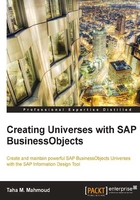
What this book covers
Chapter 1, Introduction to BI and the Semantic Layer, introduces Business Intelligence (BI), BI concepts, and Information Design Tool (IDT).
Chapter 2, Aligning BI Solutions with Business Demands, explains how to download the Northwind MS Access database and configure it in order to use it in the remaining chapters of this book. We will also discuss the business case for Northwind and will explain its data model.
Chapter 3, Creating Our First Universe, facilitates a quick walkthrough that will guide you to build your first Universe from start to finish. We will talk about the main building blocks for any Universe and we will start creating a project, connection, as well as the Data Foundation and Business layers; then we will publish this Universe. We will continue building and enriching this Universe in the remaining chapters of this book.
Chapter 4, Creating the Data Foundation Layer, introduces us to our core chapter that will cover in detail all you need to know about data connection and Data Foundation resources.
Chapter 5, Creating the Business Layer, covers in detail all that you need to know about the Business layer. Here, you can also find many best practices on how to deal with business requirements.
Chapter 6, Testing Your Universe, discusses the Universe development life cycle, how to use the Check Integrity wizard to complete the System Integration Test (SIT) for the Universe, and how to use the Queries tab in the Business layer resource to complete the User Acceptance Test (UAT).
Chapter 7, The Data Foundation Layer – Advanced Topics, covers advanced design topics that we need to take care of during the Data Foundation design phase. We will start with design concepts, then we will cover Data Foundation advanced techniques that we will use to enhance our Data Foundation design. Finally, we will talk about SQL design traps and how to fix and avoid them.
Chapter 8, The Business Layer – Advanced Topics, discusses Business layer topics such as list of values (LOV), navigation paths (hierarchies), index awareness, aggregate awareness, and Business layer's BO advanced functions (@functions).
Chapter 9, Data Security and Profiles, covers the important topic of security in detail. We will start with differentiating between the two main types of security profiles (Data Security Profile and Business Security Profile). We will learn how to use the Security Editor to create security rules and how to assign them. Finally, we will talk about security implementation best practices and how to create the security matrix.
Chapter 10, A Multiuser Development Environment, explains how designers can work more efficiently in teams and how to use Information Design Tool in the multiuser development environment using the synchronization wizard to synchronize local and shared projects. It also explains how to migrate and upgrade a Universe among BO environments.